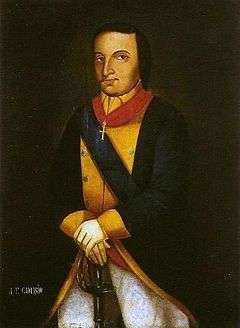Potiguara
The Potiguara (also Potyguara or Pitiguara) are an indigenous people of Brazil, South America. The Potiguara people still live in the state of Paraíba, in the municipalities of Marcação, Baía da Traição and Rio Tinto. Their population consists of sixteen thousand individuals, who occupy 26 villages in 3 reservations (Terras Indígenas): Potiguara, Jacaré de São Domingos e Potiguara de Monte-Mor. Their name, Potiguara, means "shrimp-eaters", from poty, "shrimp", and uara, "eater", according to Brazilian writer José de Alencar.[1]
Antonio Pessoa Gomes, the "Caboquinho", chief of Potiguara Indians. | |
| Total population | |
|---|---|
| 16,095 | |
| Regions with significant populations | |
| Brazil | |
| Languages | |
| Portuguese, Potiguara |
History

According to José de Alencar, the Potiguara were allies of the Portuguese during Brazil's colonial period, especially during the Dutch invasion of Brazil.[2] António Filipe Camarão, a chief of the Potiguara in the seventeenth century was rewarded with a noble title and membership in the prestigious Order of Christ for his loyal service to the crown against the Dutch invaders in Brazil. Indigenous peoples were recruited as allies on both sides of the conflict in which ultimately the Dutch were defeated and expelled.[3]
References
- Alencar, J. (1865) Iracema
- Alencar, J. (1865) Iracema
- Francis A. Dutra, "Dutch in Colonial Brazil" in Encyclopedia of Latin American History and Culture, vol. 2, p. 415. New York: Charles Scribner's Sons 1996.